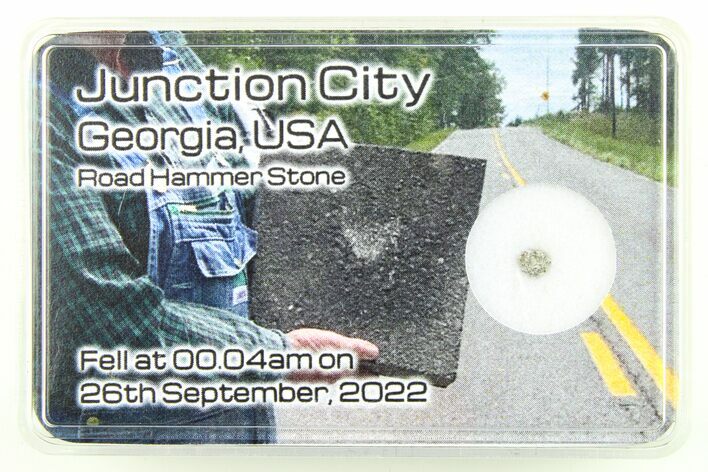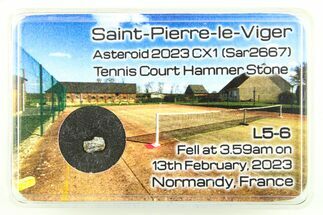.1" Junction City Chondrite Meteorite Fragment - 2022 Fall
This is a fragment from the chondrite known as Junction City, which fell near the town of the same name in Georgia on the evening of September 26, 2022. This meteorite is a hammer stone, a unique kind of meteorite that hits man-made objects and retains traces of those impacts. This particular specimen hit a portion of highway near the town!
This specimen comes in its own labeled display case.
This specimen comes in its own labeled display case.
What Is A Hammer Stone?
Hammer stones are the names given to meteorite fragments that hit man-made objects, animals, or people when they fall. Hammer stones are often identified by the scuffed fusion crusts that can contain traces of paint, rubble, or other materials from the objects they hit. Because they are so rare, they are valued collectors' items. Often the items hammer stones hit go up in value, just be being damaged by a meteorite!
Hammer stones are the names given to meteorite fragments that hit man-made objects, animals, or people when they fall. Hammer stones are often identified by the scuffed fusion crusts that can contain traces of paint, rubble, or other materials from the objects they hit. Because they are so rare, they are valued collectors' items. Often the items hammer stones hit go up in value, just be being damaged by a meteorite!
Just after midnight on September 26, 2022, observatories around western Georgia caught a fireball streaking through the sky on camera and tracked it over Talbot County, where it exploded and showered numerous stones over the town of Junction City. Over the next few days, many stones were found in its strewn field, many covered in fresh fusion crust.
This ordinary chondrite is not usually available on the market: most collected fragments reside in research collections. That makes this piece an incredibly rare find among already rare space rocks!
This ordinary chondrite is not usually available on the market: most collected fragments reside in research collections. That makes this piece an incredibly rare find among already rare space rocks!
About Chondrites
Chondrites are stony (non-metallic) meteorites that have not been modified by either melting or differentiation of the parent body. They are formed when various types of dust and small grains in the early Solar System accreted to form primitive asteroids. Some such bodies are captured in the planet’s gravity well and pulled to the surface. They are by far the most common type of meteorite, representing about 86 percent of all meteorites that have fallen to Earth.
Prominent among the components present in chondrites are the enigmatic chondrules, millimeter-sized spherical objects that originated as freely floating, molten or partially molten droplets in space; most chondrules are rich in the silicate minerals olivine and pyroxene. Chondrites also contain particles of various metals such as nickel, iron, and aluminum. These formed at the very beginning of the solar system and aggregated over time: they are the oldest rocks known on Earth!
Chondrites are divided into about fifteen distinct groups on the basis of their mineralogy, bulk chemical composition, and oxygen isotope compositions. The various chondrite groups likely originated on separate asteroids or groups of related asteroids. Each chondrite group has a distinctive mixture of chondrules, refractory inclusions, matrix (dust), characteristic chondrule sizes, and other components. Other ways of classifying chondrites include weathering and shock. The L chondrite group is the most common of these.
Chondrites are stony (non-metallic) meteorites that have not been modified by either melting or differentiation of the parent body. They are formed when various types of dust and small grains in the early Solar System accreted to form primitive asteroids. Some such bodies are captured in the planet’s gravity well and pulled to the surface. They are by far the most common type of meteorite, representing about 86 percent of all meteorites that have fallen to Earth.
Prominent among the components present in chondrites are the enigmatic chondrules, millimeter-sized spherical objects that originated as freely floating, molten or partially molten droplets in space; most chondrules are rich in the silicate minerals olivine and pyroxene. Chondrites also contain particles of various metals such as nickel, iron, and aluminum. These formed at the very beginning of the solar system and aggregated over time: they are the oldest rocks known on Earth!
Chondrites are divided into about fifteen distinct groups on the basis of their mineralogy, bulk chemical composition, and oxygen isotope compositions. The various chondrite groups likely originated on separate asteroids or groups of related asteroids. Each chondrite group has a distinctive mixture of chondrules, refractory inclusions, matrix (dust), characteristic chondrule sizes, and other components. Other ways of classifying chondrites include weathering and shock. The L chondrite group is the most common of these.
$39
TYPE
Ordinary Chondrite (Unclassified)
LOCATION
Junction City, Talbot County, Georgia
SIZE
.1" wide
CATEGORY
ITEM
#285802
 Reviews
Reviews









